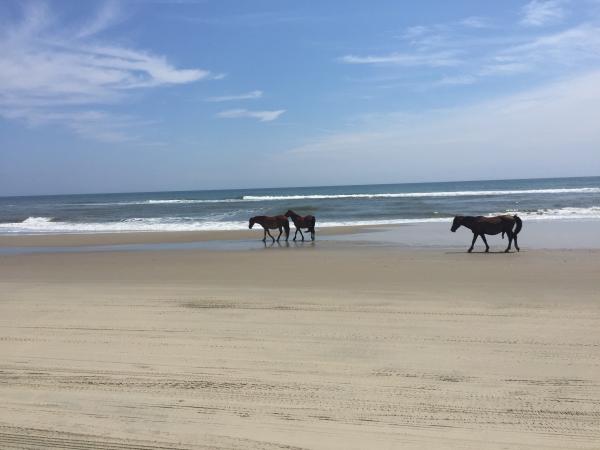KID REPORTERS’ NOTEBOOK
The Wild Horses of the Outer Banks


Wild horses on North Carolina’s Outer Banks
The pull of North Carolina’s Outer Banks for many is its long beachy shores and expansive beachfront communities. But beyond the houses on stilts are a hidden gem of nature. Wild horses roam freely in the upper 11 miles of the barrier reef island, monitored closely by the Corolla Wild Horse Fund, an organization that cares for the herd, and several companies that offer tours.
“The horses have been here for about 500 years,” said tour guide Gary Lee. “They’re descendants of Spanish shipwrecks.” Lee explained that that Spanish sailors would accidentally ram their ships into sand bars just off the coast and throw everything overboard—including livestock—to help the boat rise over the sandbar. The horses thrown overboard would swim ashore and settle on the Outer Banks. Gradually, they expanded their population. Four centuries later, in the 1920s, the herd numbered between 5,000 and 7,000. Today, the official count is 84, with speculation that there may be an additional five to 10 horses.
PROTECTING THE POPULATION
How did the horses’ population dwindle so dramatically over the past 90 years? Surprisingly, the government has been the largest factor. During the Great Depression of the 1930s, the federal government decided that there were too many horses on the Outer Banks. A bounty (monetary award) was offered to anyone who took or slaughtered a horse. In 1985, on the day that Route 12 opened in Corolla, four horses were killed by cars. It took a group of locals interested in the horses’ well-being 10 years to get permission from the North Carolina Department of Fish and Wildlife to round up the horses.
“They actually hired cowboys,” Lee said. The government gave civilians a phone number to call. Whenever someone saw a wild horse, he or she was to call the number and report it. Cowboys would then head to the location, capture the horse, and transport it to the newly-protected area. The process took two years to complete, however, because the horses were scattered over 160 miles.
The tumultuous path to the horses’ current situation surely tested the herd’s will to survive. Now, the horses are protected. Their 7,544-acre enclosure is fenced off, ensuring that no horse strays onto a busy highway or is put in harm’s way. The horses even have a beachfront view, which they share with homeowners and tourists. The horses often graze on residents’ lawns, sniff around their properties, and take shelter in their garages. Although many people pass the herd on jeep and segway tours, all humans are asked to give the horses 50 feet of space. Most important, the horses are safe, happy, and healthy, and on the path to recovering their once numerous population.
WATCH THE VIDEO
See Skylar's interview with expert Gary Lee.
